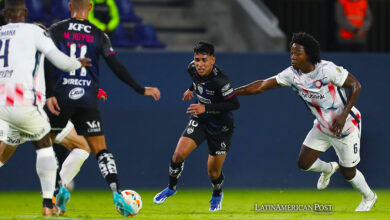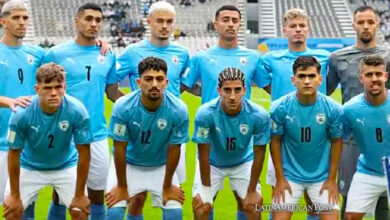Three Keys To Understand the Qatar Qualifiers
Here Are Three Key Points To Understand Everything About the Qatar Qualifiers.

The unprecedented World Cup, which for the first time in history will be held in November and December, enters the final stretch of its qualifying preliminary phase. Photo: FIFA
LatinAmerican Post | Onofre Zambrano
Listen to this article
Leer en español: Tres claves para entender las eliminatorias de Qatar
The unprecedented World Cup that will be held for the first time in history in November and December, specifically in Qatar next year, enters the final stretch with regard to its qualifying preliminary phase, to decide the 31 selected that will join with the host, after a long process that has undergone many changes due to the pandemic.
The qualifiers are the filter for the participants of each World Cup, so it is impossible for you to see the same countries from the previous World Cup repeat in the next one. It is not invitational like the Copa América, for example, but each country must play for its participation every four years. Previously, the defending monarch and the host country had a guaranteed place, but since Germany 2006, only the host has his ticket guaranteed, which gives greater importance to this previous tournament.
The one in 2022 will be the last World Cup with 32 national teams since for the 2026 edition that the United States, Canada, and Mexico will jointly organize, the number of participants will rise to 48. In the case of Conmebol, the first thing to understand is the format, it is also necessary to clarify how many places each confederation has in the ecumenical event, why it gives that number of places, and finally, how the repechages are applied.
Conmebol Format
It is the smallest confederation in terms of participants, just 10, but at the same time the second most important after UEFA, based on the titles won and the level of competitiveness.
Until the 1994 United States edition, the tie was played under the format of two groups of five teams, with Brazil and Argentina always in different areas, and the total of matches was 8. The two best of each group classified and if there was a play-off , the best third.
But since then, the format has become a single group, with everyone playing against everyone in two rounds for a significant number of 18 matches. There are no playoffs or rounds as if it happens in Africa, Concacaf, Oceania and Asia, so it becomes a long-term race in which the four best-placed go directly to the World Cup and the fifth plays repechage with Asia, Concacaf or Oceania, as determined by FIFA, as that condition changes for some qualifiers.
Currently, Conmebol's qualifying phase has only played 6 games of the 18 due to the suspension of the two FIFA dates in March in both 2020 and 2021, and for that reason, now in September and then in October, there will be an extraordinary situation of three games in a week for each team, when traditionally there are two games in five days.
With this strategy, Conmebol recovers two dates and the remaining two pending dates will be recovered in January, when there is no FIFA date to match the calendar and culminate in March 2022, as planned, the itinerary of the South American teams.
Also read: Cristiano Ronaldo: The challenges He Will Face On His Arrival at Manchester United
Granting of quotas
Since France 1998 the World Cup has been played with 32 countries and the distribution of the quotas is applied as follows: 13 for UEFA (Europe), 5 for CAF (Africa), 4.5 for Conmebol (South America) and AFC (Asia ), 3.5 to Concacaf (North America, Central America and the Caribbean) and 0.5 to OFC (Oceania).
The highest European body grants Europeans the most quotas for the World Cup, because this allocation is made from the number of teams registered in each confederation and Europe is the one that has the most with 55. But this measure is not strictly adhered to. Because in the case of Conmebol, despite being the smallest in the number of countries, it is the third that receives the most places, since, out of 10 teams, four advance directly.
The opposite occurs with Concacaf and it is controversial, because in South America almost half of those who participate in the qualifiers classify, and from now on we wonder how the distribution will be for the next 2026 World Cup where each confederation will see its number of participants expand . The truth is that, for North America, Central America and the Caribbean, the quota is only 3.5 despite the fact that there are 41 countries registered in FIFA, and therefore competing in the qualifying rounds.
Other qualifying rounds that stand out for their difficulty are the African rounds, in which there are several high-level teams and, therefore, they give away five tickets. National teams like Senegal, Cameroon, Ivory Coast, Egypt, Algeria, Morocco, Ghana, and Nigeria; they are very competitive and contribute a good number of players to the elite of club football. In this case, they have a quota more than South America for the number of countries that dispute it, a total of 40 nations.
Asia is one of the weakest confederations, but it has established 4.5 quotas due to the large number of nations participating in its qualifying rounds, a total of 46. Finally, Oceania appears, which is the least powerful confederation, and also with a small number of countries, only 11. They only have 0.5 quotas.
The playoffs
It is a sudden death tie between two countries, which is played in two round-trip matches (home and away) and in which the winner traditionally keeps one of the last available spots. The region will depend on what FIFA decides in the previous one.
For example, in the qualifying rounds for Russia 2018, Peru was fifth in America and qualified in a play-off against New Zealand, which was, in turn, the champion of Oceania. For 2022, FIFA has not yet determined how the play-offs will be played, so Conmebol's fifth can go against Concacaf, Asia or Oceania.
Africa does not dispute playoffs because it has five places insured, and Europe does, but between themselves. Normally the seconds of each group, which are traditionally 8 to 10, play a repechage with each other to determine the remaining 4 or 5 places of the old continent. The entire repechage phase should be played before the World Cup group draw, to be held in June.
La CONCACAF estrena un nuevo formato para la fase final de sus eliminatorias a la Copa Mundial.https://t.co/5DmnmKeSWn
— Lobo 97.7 (@Lobo977FM) September 1, 2021




